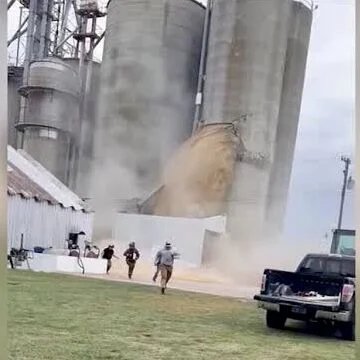In the quiet rural town of Martinton, Illinois, on October 16, 2025, a grain silo at a local farmers' co-op suddenly gave way, spilling tons of soybeans and creating a massive dust cloud. The viral video showed workers running for safety as the structure cracked and collapsed. Commenters, though relieved no one was injured, highlighted the close call with a potential dust explosion. Cracks had appeared earlier that day, prompting an evacuation hours before the failure, a stark reminder that aging silos are often ticking time bombs in America's agricultural heartland.
This incident isn't unique. Grain silos across the Midwest and beyond face mounting pressures: trade disruptions leading to crop surpluses, and climate variability causing uneven grain moisture levels. Users noted extra soybeans were "busting open at the seams" due to overflow. Fortunately, the dust didn't ignite, but the visible spark in the video was a nervous point of discussion. Grain dust is highly flammable, and historical explosions have claimed lives and caused millions in damages. These events underscore the urgent need for better monitoring to prevent overloads, detect structural stress early, and mitigate explosion risks.
Enter millimeter-wave radar level gauges (MMW)—a sophisticated, non-contact technology revolutionizing grain storage safety. These sensors provide precise, real-time level measurements even in dusty, harsh environments. Unlike traditional methods like mechanical probes or ultrasonic sensors, which fail due to buildup or interference, MMW radar penetrates dust clouds with ease, ensuring reliable data. In this comprehensive guide, we'll delve into the workings of this technology, its superior advantages, real-world applications, and why it's essential for modern farms.
⚠️ Understanding the Perils of Grain Storage
Grain silos, while vital, harbor inherent dangers that can escalate quickly without proper oversight.
1. Structural Failure: Overload and Deterioration
Failures like the one in Martinton occur when silos are overfilled or when materials distribute unevenly, exerting undue pressure. Many silos, like the 50-year-old structure mentioned, suffer from concrete degradation under constant stress. Prioritizing short-term profits often means neglecting the regular maintenance and structural integrity checks recommended by organizations like the American Concrete Institute (ACI) and OSHA.
2. The Lethal Threat of Dust Explosions
As grain is loaded or unloaded, fine airborne particles mix with oxygen, creating a combustible atmosphere. A single spark—from static or equipment—can trigger a massive blast. This occurs when the air concentration of dust exceeds the Lower Explosive Limit (LEL) and all elements of the "Dust Explosion Pentagon" (Fuel, Oxygen, Ignition Source, Dispersion, and Confinement) are present. Safety agencies report dozens of incidents annually, often in facilities lacking modern explosion-proof systems.
3. Operational and Environmental Challenges
Moisture can cause grain spoilage and clumping, leading to bridging (where material arches and blocks flow) or uneven settling that stresses walls. The long-term, high-volume storage spurred by trade issues increases wear. Traditional level measurement tools fall short here: mechanical systems wear out, and ultrasonics are blinded by particulates. MMW radar provides the robust, accurate solution.
📡 How Millimeter-Wave Radar Level Gauges Work
MMW radar level gauges use high-frequency electromagnetic waves to precisely measure the distance to the grain surface.
-
Signal Emission: The sensor, mounted at the silo top, emits short pulses or a Frequency Modulated Continuous Wave (FMCW). Frequencies around 80 GHz are often favored because they produce a very narrow, focused beam optimal for solids measurement.
-
Reflection and Detection: The waves hit the grain surface and reflect back. The sensor analyzes the time-of-flight or frequency shift to determine the exact distance.
-
Technical Advantage: The shorter wavelengths of MMW easily penetrate dense dust layers with minimal attenuation. Furthermore, the narrow beam angle significantly improves accuracy by minimizing reflections (known as clutter) from the silo walls.
-
-
Data Processing and Output: Integrated processors convert the distance data into useful metrics like fill percentages or volumes, factoring in the silo's geometry. Outputs are ready for integration or wireless connectivity for remote monitoring via IoT platforms.
✅ Advantages of Millimeter-Wave Radar for Silo Level Measurement
The superiority of MMW radar stems from several critical benefits:
-
Superior Penetration Through Dense Dust: High-frequency waves cut through thick dust and vapor that would obstruct older technologies, ensuring stable readings during high-activity loading periods.
-
Pinpoint Accuracy via 80 GHz Technology: These non-contact gauges handle low-dielectric materials like corn or soybeans with high precision, easily outperforming contact-based and ultrasonic systems.
-
True Non-Contact, Zero-Maintenance Operation: With no moving parts, there is minimal downtime. Installation is simple, and the devices are highly resistant to condensation, corrosion, and material adhesion.
-
Integrated Explosion Safety & Hazard Certification: By providing early warnings of overfills, they prevent the conditions that lead to dust buildup. Many models are certified for hazardous areas, integrating seamlessly with explosion-proof circuits.
-
Optimized Inventory and Logistics: Real-time data enables sophisticated inventory management, which reduces spoilage and improves logistics, driving a quicker return on investment (ROI).
📈 Case Studies: Millimeter-Wave Radar in Action
Real-world applications showcase the MMW impact:
-
At a major Midwest grain facility, MMW sensors provided stable, reliable measurements where ultrasonics had previously failed, significantly reducing false alarms and improving operational confidence.
-
In university research, MMW radar was used to map grain distribution and caking inside silos, proactively preventing the uneven loading that can lead to catastrophic collapses.
-
Companies like linpowave have integrated these sensors into smart farming systems, using IoT protocols to provide continuous level and density data, alerting operators remotely to potential spoilage or overfill risks during peak harvest.
🛠️ Implementing Millimeter-Wave Radar: Practical Considerations
Adopting MMW technology begins with assessing your silo size, material type, and environment.
-
Installation: It's non-contact and generally involves simple mounting on the silo roof, often compatible with solar power solutions.
-
Cost and Maintenance: While initial costs are moderate, the long-term maintenance is low due to no moving parts. The payback period is short due to significantly reduced loss from overfills or spoilage.
-
Retrofitting Old Silos: For older structures like the one in Martinton, retrofitting with MMW radar is a cost-effective way to extend the lifespan and dramatically improve the safety profile.
-
Safety Compliance: Always ensure your chosen sensor models possess the appropriate explosion-rated enclosures and certifications for hazardous grain environments.
Conclusion: A Safer Future for Agriculture
The Illinois silo collapse is a wake-up call: as global food demand rises, we cannot afford to rely on outdated monitoring technology. Millimeter-Wave Radar Level Gauges offer a reliable, innovative solution that actively prevents overloads, minimizes explosion risks, and boosts operational efficiency. By embracing this technology, farmers can safeguard lives, protect assets, and ensure their businesses thrive in an unpredictable world.
FAQ: Common Questions About Millimeter-Wave Radar Level Gauges
Q: What is the typical accuracy of MMW radar for grain silos? A: Most models achieve sub-inch accuracy, far surpassing ultrasonic sensors, especially in dusty conditions.
Q: Why is the 80 GHz frequency often preferred for grain measurement? A: 80 GHz generates an extremely narrow, focused beam, which is highly effective at penetrating dust while minimizing interference (clutter) from the silo walls.
Q: How does MMW handle dust better than other sensors? A: Its short wavelengths pass through dust with low attenuation, unlike optical or ultrasonic methods that get physically blocked or scattered.
Q: What measuring technique is typically used? A: The industry standard for continuous, high-accuracy measurement in solids is often FMCW (Frequency Modulated Continuous Wave) radar.
Q: How does it contribute to explosion prevention? A: By providing continuous, reliable level monitoring, it ensures facilities do not overfill, which is the primary cause of dangerously high airborne dust concentrations.
Ready to assess your grain storage safety needs?



